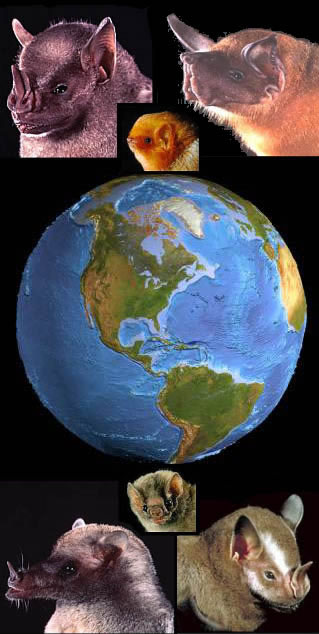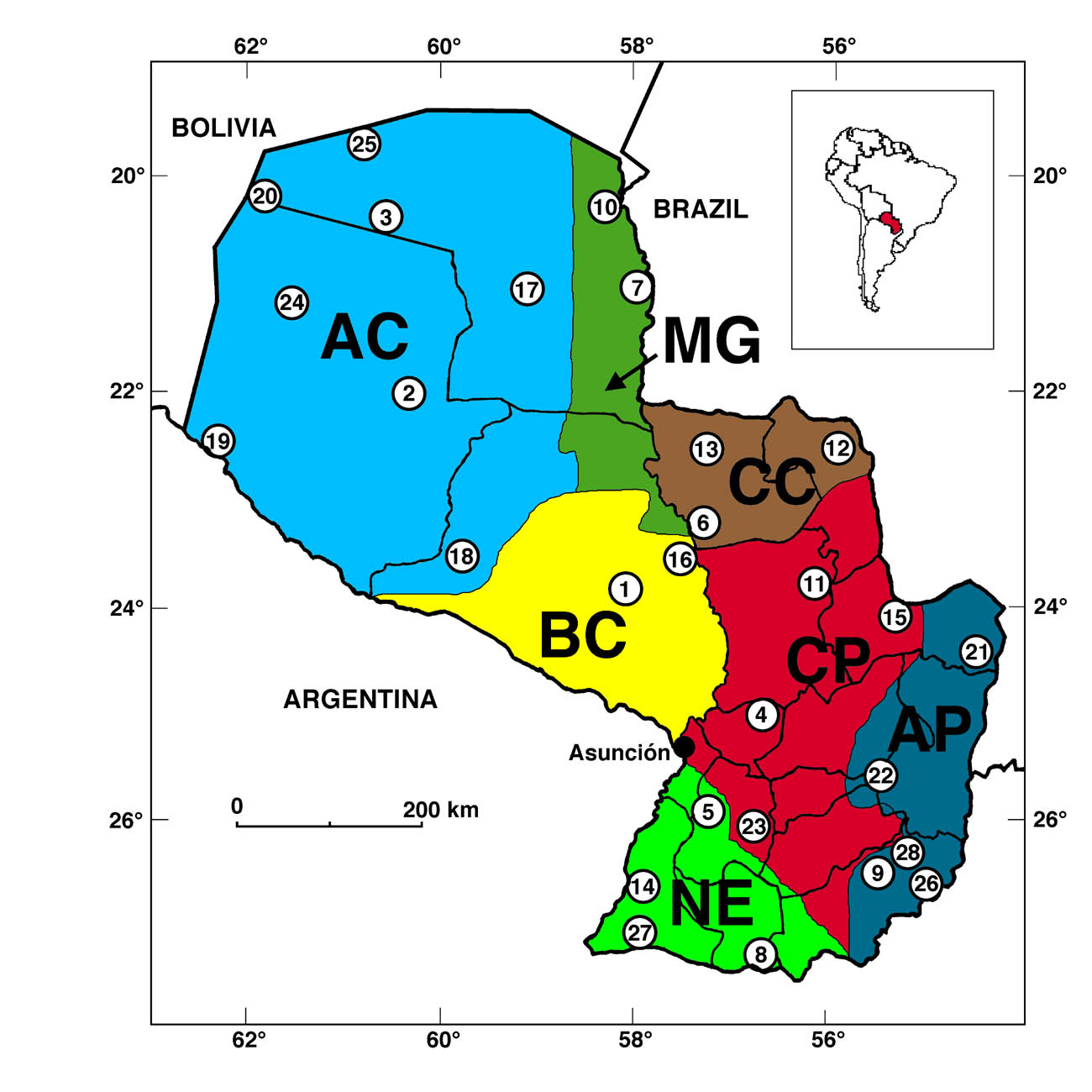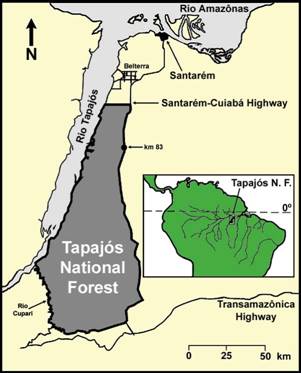Conservation Biology
Conservation in the American Tropics.--Four recent or ongoing projects in South America, one in Paraguay (NSF-funded), one in Brazil (USDA-funded), and two in Peru (NIH-funded), investigate the effects of habitat loss and fragmentation on population-level (i.e., abundance) and community-level (i.e., species composition, species diversity, and guild strucutre) attributes of the fauna. Research in the Tapajos National Forest seeks to assess the differential responses of birds and bats to natural and anthropogenic disturbance in Amazonian Terra Firme forest. Research in Paraguay has documented the composition and diversity of the small mammal fauna at 25 sites distributed throughout the seven major biomes of the country, and assessed the efficacy of site selection algorithms to achieve conservation goals. More intensive work in Interior Atlantic Rainforest has focused on the scale-dependent effects of forest fragmentation on population and community characteristics of local bat faunas. Finally, work in Peru is focusing on the way in which forest fragmentation affects the population biology and community ecology of host (bats, rodents, and marsupials) and vector (mosquitoes) species, thereby altering the dynamics of disease transmission between arborviruses and humans. A recently funded grant to NIH’s Ecology of Infectious Disease program focuses on similar research questions related to spirochete-transmitted disease (Leptospriosis) in lowland Amazonia.
Conservation in the Caribbean.--Ongoing research in Puerto Rico funded by the U.S. Fish and Wildlife Service has focused on the status of Stenoderma rufum in particular, and the other twelve species of bats on the island in general.Although S. rufum is a species of bat that is endemic to Puerto Rico as well as to St. Thomas and St. John, there are no documented records of its presence outside of Puerto Rico for well over 30 years. Michael Gannon (my first doctoral student) and I have been focusing research efforts on Stenoderma on Puerto Rico for the past two decades. In particular, we have show that this species is quite sensitive to disturbances such as Hurricanes. This suggests that the species may require special consideration in conservation planning because Puerto Rico in particular and the Caribbean basin in general is a disturbance-mediated system in which hurricanes and tropical storms play a dominant role in molding the composition of local biotas and the ecosystem properties which they support.. For example, after Hurricane Hugo, the absolute and relative densities of S. rufum declined precipitously in the Luquillo Experimental Forest. Moreover, the post-hurricane absence of pregnant or lactating females, as well as the absence of sub-adults or juveniles in the local population (Gannon and Willig, 1992) suggested that S. rufum maybe be critically endanged on the Puerto Rico (Gannon and Willig, 1994; Willig and Gannon, 1996; Gannon and Willig, 1998). Consequently, we inititated a broad survey of the island, with particular focus on protected areas (i.e., Commonwealth Forests and National Forests) to determine the distributional and demographic status of S. rufum on Puerto Rico. Detailed information about this species is detailed in a recently published book (2006) by Texas Tech Press entitled The Bats of Puerto Rico: An Island Focus and Caribbean Perspective, with M.R. Gannon, M. Rogriguez-Duran, A. Kurta, and M.R Willig as co-authors.
Bats of Puerto Rico.--Along with three collaborators (M.R. Gannon at Penn State University, M. Rodriguez-Duran at Interamerican University in Puerto Rico, and A. Kurta of Eastern Michigan University), I have combined historical records on the distribution, ecology, behavior, conservation status, and systematics of Puerto Rico's 13 species of bats, with detailed data that we have obtained over the past score of years, to produce a book that examines the biology of bats on Puerto Rico. This book, currently under contract to Texas Tech University Press, entitled The Bats of Puerto Rico: An Island Focus and Caribbean Focus, provides useful information about the status of all native mammals species on the island, as well as introduced species and extinct species. Conservation Planning.--On going research has focused on conservation planning at the national level, within the Paraguay, and at the hemispheric level, for the continental New World. In both cases, research has been in collaboration with Sandy Andelman (Conservation International, Washington, DC).
New World Bats At a hemispheric scale in the continental New World, we assessed the spatial distribution of protected areas, as well as their a adequacy for conserving bat species. We show (Andelman and Willig 2003) that current protected areas are too few, too small, and too geographically restricted to conserve adequately bat biodiversity. In addition, we used a simulated annealing algorithm to identify areas for future conservation investment. Regardless of a number of conservation scenarios, ten areas emerge as high priorities for investment, based on irreplaceability analysis, including subtropical Mexico, MesoAmerica, Tropical Andes, Choco-Darien Region, Brazilian Cerrado, Baja California, Venezuelan Llanos, the southern Andes of Argentina and Chile, the Amazon Basin, and the Guiana Shield.
Paraguayan Bats
The application of systematic and quantitative approaches to conservation planning is increasing; however, the quality and quantity of data available to planners remains inadequate. Sandy Andelman and I have used two databases on bat species distributions at 25 sites in Paraguay (Willig et al. 2000) to illustrate some of the consequences of the spatial scale of sampling and data quality on decisions about reserve-siting. We used a simulated annealing algorithm to identify alternative scenarios for comprehensive representation of the nation’s bat fauna within a system of reserves and to evaluate the contribution of existing protected areas in Paraguay to this conservation goal. The location, efficiency, and level of protection (i.e., the number of populations of each species protected) were affected by both spatial scale and source of data. Our results suggest that systematic and intensive biodiversity surveys are an important element of efficient conservation planning for biodiversity.
As human population size increases, demand for natural resources will increase. Logging pressure related to increasing demands continues to threaten remote areas of Amazonian forest and is one of the main causes of degradation of Amazonian tropical forests. Bats may represent keystone taxa in the Neotropics, as they are primary agents of pollination and seed dispersal for many pioneer plants and their activities promote forest regeneration. A harvest protocol is required to provide renewable timber resources that meet consumer needs while minimizing negative effects on biodiversity and ecosystem services. Reduced-impact logging (RIL) may be a viable option to achieve these goals. We assessed the impact of low harvest (18 m3/ha), reduced-impact logging (RIL) on population and community characteristics of phyllostomid bats in Amazonian terra firme forest of Brazil at 20-42 mo post-harvest. Based on 168,192 net-meter-hours, 4,144 bats were recorded representing 55 species, 36 genera, 6 families, and 6 broad guilds. Population-level responses of common phyllostomids to RIL were minor, with 10 of 15 species evincing no change in mean abundance. Of those taxa responding to RIL, three increased (Artibeus concolor, Artibeus lituratus, and Glossophaga soricina) and two decreased (Carollia brevicauda and Carollia perspicillata) in abundance. Ten species (one nectarivore, two gleaning animalivores, and seven frugivores) responded to forest habitat in a consistent manner: nine were more abundant in closed canopy sites and one was more abundant in gaps. Using qualitative measures (i.e. changes in status from common to rare or from present to absent), RIL elicited negative responses from 16 species, mostly rare taxa. After accounting for differences in total number of collected individuals, control forest harbored seven to 15 more rare species than did forest subjected to RIL. Compositional (species distributions) and structural (rank distributions) aspects of bat assemblages differed between cut and control forests. More specifically, bat assemblages in cut forest had increased diversity and decreased dominance compared to control forest. In the short-term, RIL generally did not negatively affect populations of abundant bats. In contrast, reductions in abundance or local extirpation in response to RIL generally characterized uncommon or rare species. Arrangement of RIL sites in a matrix of undisturbed forest may allow source-sink dynamics to mitigate effects of RIL on rare or sensitive species and enhance sustainability at a regional scale. |
||||||
Please contact steven.presley@uconn.edu or michael.willig@uconn.edu if you have questions, comments, or corrections. Unless otherwise indicated, figures, tables, and images that appear on this page may not be used, reproduced, copied, or posted elsewhere, for any reasons, without permission. |




